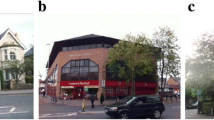Abstract
This study examined public attitudes concerning the value of outdoor spaces which people use daily. Two successive analyses were performed based on data from common residents and college students in the city of Hangzhou, China. First, citizens registered various items constituting desirable values of residential outdoor spaces through a preliminary questionnaire. The result proposed three general attributes (functional, aesthetic and ecological) and ten specific qualities of residential outdoor spaces. An analytic hierarchy process (AHP) was applied to an interview survey in order to clarify the weights among these attributes and qualities. Second, principal factors were extracted from the ten specific qualities with principal component analysis (PCA) for both the common case and the campus case. In addition, the variations of respondents’ groups were classified with cluster analysis (CA) using the results of the PCA. The results of the AHP application found that the public prefers the functional attribute, rather than the aesthetic attribute. The latter is always viewed as the core value of open spaces in the eyes of architects and designers. Furthermore, comparisons of ten specific qualities showed that the public prefers the open spaces that can be utilized conveniently and easily for group activities, because such spaces keep an active lifestyle of neighborhood communication, which is also seen to protect human-regarding residential environments. Moreover, different groups of respondents diverge largely in terms of gender, age, behavior and preference.
Similar content being viewed by others
References
Altman, I., Wandersman, A., 1987. Neighborhood and Community Environments. Plenum Press, New York.
Aczel, J., Saaty, T.L., 1983. Procedures for synthesizing ratio judgments. Journal of Mathematical Psychology, 27(1):93–102. [doi:10.1016/0022-2496(83)90028-7]
Berry, D., 1976. Preservation of open space and the concept of value. The American Journal of Economics and Sociology, 35(2):113–124. [doi:10.1111/j.1536-7150.1976.tb02985.x]
Canter, D., 1983. The purposive evaluation of places: a facet approach. Environment and Behavior, 15:659–698.
Cybriwsky, R., 1999. Changing patterns of urban public space: observations and assessments from the Tokyo and New York metropolitan areas. Cities, 16(4):223–231. [doi:10.1016/S0264-2751(99)00021-9]
Duke, J.M., Rhonda, A.H., 2002. Identifying public preferences for land preservation using the analytic hierarchy process. Ecological Economics, 42(1):131–145. [doi:10.1016/S0921-8009(02)00053-8]
Forman, E.H., Selly, M.A., 2001. Decision by Objectives. World Scientific Publishing Co.
Gardner, B.D., 1977. The economics of agricultural land preservation. American Journal of Agricultural Economics, 59(5):1027–1036. [doi:10.2307/1239883]
Gehl, J., 1987. The Life between Buildings—Using Public Space. van Nostrand Reinhold, New York.
Hangzhou Bureau of Statistics, 2005. Hangzhou Statistical Yearbook 2005. http://www.hzstats.gov.cn/english/
Ji, C., 1631. Yuan Ye (in Chinese). Translated by Hardie, A., 1988. The Craft of Gardens. Yale University Press, New Haven.
Kline, J., Wichelns, D., 1994. Using referendum data to characterize public support for purchasing development rights to farmland. Land Economics, 70(2):223–233. [doi:10.2307/3146324]
Kline, J., Wichelns, D., 1998. Measuring heterogeneous preferences for preserving farmland and open space. Ecological Economics, 26(2):211–224. [doi:10.1016/S0921-8009(97)00115-8]
Marus, C.C., Francis, C., 1998. People Places—Design Guidelines for Urban Open Space. John Wiley & Sons Inc.
Saaty, T.L., 1980. The Analytic Hierarchy Process. McGraw-Hill Inc.
Shi, J., Ge, J., Hokao, K., 2005. Campus lifestyle and its relationship with residential environment evaluation—a case study of Hangzhou City, China. Journal of Asian Architecture and Building Engineering, 4(2):323–330.
Simon, H.A., 1960. The New Science of Management Decision. Harper and Brothers, New York.
Stokols, D., 1995. The paradox of environmental psychology. American Psychologist, 50(10):821–837. [doi:10.1037/0003-066X.50.10.821]
Vaidya, O.S., Kumar, S., 2006. Analytic hierarchy process: an overview of applications. European Journal of Operational Research, 169(1):1–29. [doi:10.1016/j.ejor.2004.04.028]
Vargas, L., 1990. An overview of analytic hierarchy process: its applications. European Journal of Operational Research, 48(1):2–8. [doi:10.1016/0377-2217(90)90056-H]
Wang, H.L., 1996. A Review of the Landscape of a Parkway—Case Study of Parkway in Taichung. 8th IFLA Eastern Regional Conference. Hong Kong, p.61–66.
Wu, K.P., 2002. A Study of Visitors’ Satisfaction with Urban Parkway Facilities—A Case Study on Ching-Kuo Parkway in Taichung City. MS Thesis, Feng Chia University, Taichung, Taiwan (in Chinese).
Wu, S., Huo, Y., Li, J., Zhang, S., 1995. Evaluation of factors affecting the living and environmental quality of resident areas. Journal of Environment Science, 15(3):354–362 (in Chinese).
Xu, L., Yang, G., 1996. Research on the residential environment evaluation in Shanghai. Journal of Tongji University, 24(5):546–551 (in Chinese).
Zahedi, F., 1986. The analytic hierarchy process: a survey of methods and its applications. Interfaces, 16(4):96–108.
Zhu, X., Wu, S., 2002. Multi-level comprehensive evaluation of college campus environment quality. City Planning Review, 26(10):57–60 (in Chinese).
Author information
Authors and Affiliations
Rights and permissions
About this article
Cite this article
Shi, Jr., Zhao, Xm., Ge, J. et al. Relationship of public preferences and behavior in residential outdoor spaces using analytic hierarchy process and principal component analysis—a case study of Hangzhou City, China. J. Zhejiang Univ. - Sci. A 7, 1372–1385 (2006). https://doi.org/10.1631/jzus.2006.A1372
Received:
Accepted:
Published:
Issue Date:
DOI: https://doi.org/10.1631/jzus.2006.A1372
Key words
- Public preference
- Open space
- Analytic hierarchy process (AHP)
- Principal component analysis (PCA)
- Cluster analysis (CA)




